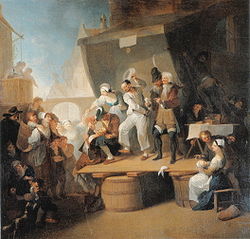Microscope,The Dental cosmos (1907)
Identifier: dentalcosmos4919whit (find matches)
Title: The Dental cosmos
Year: 1907 (1900s)
Authors: White, J. D McQuillen, J. H. (John Hugh), 1826-1879 Ziegler, George Jacob, 1821-1895 White, James William, 1826-1891 Kirk, Edward C. (Edward Cameron), 1856-1933 Anthony, L. Pierce (Lovick Pierce), b. 1877
Subjects: Dentistry Dentistry
Publisher: Philadelphia, S. S. White Dental Manufacturing Co
Contributing Library: Yale University, Cushing/Whitney Medical Library
Digitizing Sponsor: The College of Physicians of Philadelphia and the National Endowment for the Humanities
View Book Page: Book Viewer
About This Book: Catalog Entry
View All Images: All Images From Book
Click here to view book online to see this illustration in context in a browseable online version of this book.
Text Appearing Before Image:
e used. There is attached to this microscope a small he fields of vision can be made to ap-pear as one single field. The instrument is light and easily ma-nipulated, requiring little of the techniquewhich the old microscopes demanded, and al-ready it has entered the field of the plant -hybridizer, and is being used by gardenerswho never in their lives saw through theordinary microscope. In botany—especially in the study of plant 360 THE DENTAL COSMOS. diseases—ii has quickly become invaluable:while in metallurgy, zoology, and in manyother branches, it is rapidly becoming quite.i- necessary an instrument of research as isthe old microscope. It has revolutionizedthe study of corals. I am informed, and theentomologists say that it has revealed entirelynew characters in insects. it one of your diabolical instruments to ascertain whether or not the nerve is exposed. Yours very sincerely, David Fairchild. Owing to the impossibility of havingthe proper light in this room we could Fig. 2.
Text Appearing After Image:
I believe that could we get the instrumentin position to look into the mouth of a patientin the chair, its own wonderful revelationswould win for it the place it deserves to oc-cupy in the art which of all others demandsattention to the minutest details. In ourjoint designs for a stand to hold this instru-ment. I think we have been in a measure suc-cessful, though I trust important improve-ment - will be made in it. You will find its weak points by practice,but I cannot help feeling that it is lo plat-an important role in the future of scientificdentistry. As a representative of Unit largoand silently suffering class, your patients.1 trust the time is not far distant when youwill look into a cavity before vou thrust into not exhibit the microscope to you to-night. Jn lieu of that, Mr. President,I will hand you a half-dozen photographswhich will show the microscope in focusupon a patient in the chair. These pho-tographs also show the standard whichhas been constructed to carry the micr
Note About Images
Relevante Bilder
Relevante Artikel
Geschichte der ZahnmedizinDie Geschichte der Zahnmedizin oder Geschichte der Zahnheilkunde umfasst die Entwicklungen in der Zahnheilkunde einschließlich der Beiträge von Personen, die die Zahnmedizin ihrer Zeit beeinflussten. Sie ist ein Teil der Medizingeschichte und reicht bis in die Urgeschichte zurück. Die konservierende Behandlung von Zähnen wurde bei einem 14.000 Jahre alten männlichen Individuum aus der Felshöhle von Riparo Villabruna bei Sovramonte in Norditalien festgestellt, ferner für die Zeit um 5500 bis 7000 v. Chr. bei Bauern in Pakistan. Kariöse Zähne wurden präzise aufgebohrt, möglicherweise verbunden mit einer anschließenden Füllung des Hohlraums. Ebenfalls aus der Jungsteinzeit stammt ein Backenzahn aus Dänemark, an dem eine Trepanation vorgenommen wurde. Die ersten zahntechnischen Arbeiten wurden Mitte des 1. Jahrtausends v. Chr. von Etruskern und Phöniziern angefertigt. Der Einfluss römischer und griechischer Gelehrter war im Mittelalter im christlichen wie im arabischen Raum bestimmend. Die arabischen Erkenntnisse gelangten zusammen mit vielen antiken durch die Übersetzerschule von Toledo und über Salerno in den abendländischen Raum, in dem die Zahnheilkunde durch die Barbiere ausgeübt wurde. .. weiterlesen










































